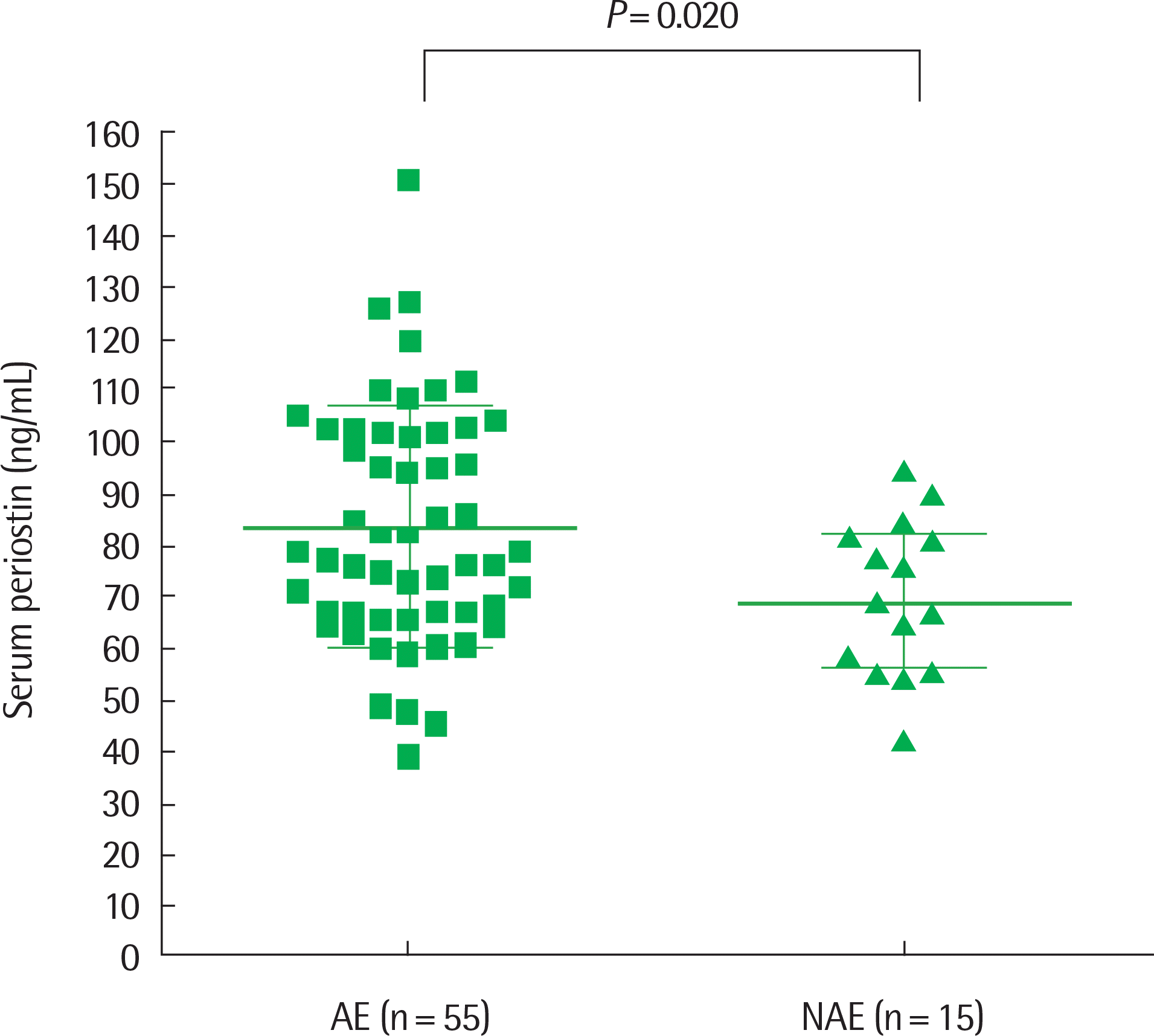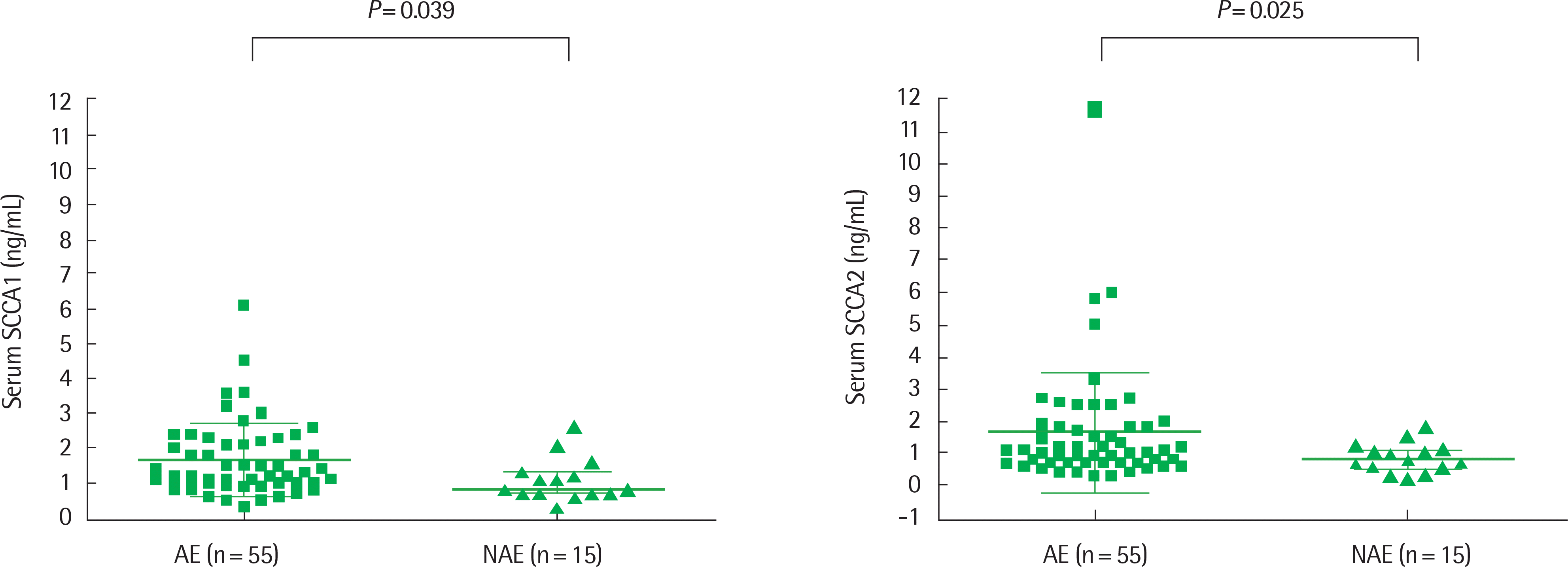Abstract
Purpose
It was found that periostin and squamous cell carcinoma-related antigens (SCCAs) were strongly interleukin-13-inducible gene products. This study measures the serum periostin and SCCA levels in children suffering from atopic dermatitis (AD) and to evaluate the association between the severity of AD and their values.
Methods
Seventy AD children aged 1 month to 10 years were included in our study. Subjects were characterized as having atopic eczema (AE; n=55) or non-AE (NAE; n=15) by atopic sensitization. Serum SCCA and periostin levels were measured.
Results
The serum periostin levels were significantly higher in children with AE than in those with NAE (geometric mean [95% confidence interval]: 80.47 ng/mL [75.06–85.93 ng/mL] vs. 67.45 ng/mL [59.99–75.64] ng/mL, P=0.020). The serum concentrations of both SCCA1 and SCCA2 were significantly higher in children with AE than in those with NAE (geometric mean [95% confidence in-terval]: 1.401 [1.198–1.643] ng/mL vs. 0.969 [0.723–1.268] ng/mL, P=0.039 for SCCA1) (1.178 [0.974–1.455] ng/mL vs. 0.711 [0.540–0.994] ng/mL, P=0.025 for SCCA2). The serum periostin levels were significantly correlated with disease severity and with peripheral blood eosinophil counts. The SCCA levels were not significantly correlated with disease severity. Both SCCA1 and SCCA2 were significantly correlated with serum periostin levels and blood eosinophil counts.
Go to : 
REFERENCES
1. Asher MI, Montefort S, Björkstén B, Lai CK, Strachan DP, Weiland SK, et al. Worldwide time trends in the prevalence of symptoms of asthma, allergic rhinoconjunctivitis, and eczema in childhood: ISAAC Phases One and Three repeat multicountry cross-sectional surveys. Lancet. 2006; 368:733–43.

2. Hamid Q, Boguniewicz M, Leung DY. Differential in situ cytokine gene expression in acute versus chronic atopic dermatitis. J Clin Invest. 1994; 94:870–6.

3. Hamid Q, Naseer T, Minshall EM, Song YL, Boguniewicz M, Leung DY. In vivo expression of IL-12 and IL-13 in atopic dermatitis. J Allergy Clin Immunol. 1996; 98:225–31.

4. Novak N, Bieber T. Allergic and nonallergic forms of atopic diseases. J Allergy Clin Immunol. 2003; 112:252–62.

5. Leung DY, Boguniewicz M, Howell MD, Nomura I, Hamid QA. New insights into atopic dermatitis. J Clin Invest. 2004; 113:651–7.

6. Grewe M, Bruijnzeel-Koomen CA, Schöpf E, Thepen T, Langeveld-Wild-schut AG, Ruzicka T, et al. A role for Th1 and Th2 cells in the immuno-pathogenesis of atopic dermatitis. Immunol Today. 1998; 19:359–61.

7. Kii I, Amizuka N, Minqi L, Kitajima S, Saga Y, Kudo A. Periostin is an extracellular matrix protein required for eruption of incisors in mice. Biochem Biophys Res Commun. 2006; 342:766–72.

8. Kikuchi Y, Kashima TG, Nishiyama T, Shimazu K, Morishita Y, Shimaza-ki M, et al. Periostin is expressed in pericryptal fibroblasts and cancer-associated fibroblasts in the colon. J Histochem Cytochem. 2008; 56:753–64.

9. Masuoka M, Shiraishi H, Ohta S, Suzuki S, Arima K, Aoki S, et al. Periostin promotes chronic allergic inflammation in response to Th2 cytokines. J Clin Invest. 2012; 122:2590–600.

10. Kato H, Torigoe T. Radioimmunoassay for tumor antigen of human cer-vical squamous cell carcinoma. Cancer. 1977; 40:1621–8.

11. Yuyama N, Davies DE, Akaiwa M, Matsui K, Hamasaki Y, Suminami Y, et al. Analysis of novel disease-related genes in bronchial asthma. Cytokine. 2002; 19:287–96.

12. Nishi N, Miyazaki M, Tsuji K, Hitomi T, Muro E, Zaitsu M, et al. Squamous cell carcinoma-related antigen in children with acute asthma. Ann Allergy Asthma Immunol. 2005; 94:391–7.

13. Mitsuishi K, Nakamura T, Sakata Y, Yuyama N, Arima K, Sugita Y, et al. The squamous cell carcinoma antigens as relevant biomarkers of atopic dermatitis. Clin Exp Allergy. 2005; 35:1327–33.

14. Suzuki K, Inokuchi A, Miyazaki J, Kuratomi Y, Izuhara K. Relationship between squamous cell carcinoma antigen and the clinical severity of allergic rhinitis caused by Dermatophagoides farinae and Japanese cedar pollen. Ann Otol Rhinol Laryngol. 2010; 119:22–6.

15. Hanifin JM, Rajka G. Diagnostic features of atopic dermatitis. Acta Derm Venereol Suppl (Stockh). 1980; 92:44–7.
16. Severity scoring of atopic dermatitis: the SCORAD index. Consensus Report of the European Task Force on Atopic Dermatitis. Dermatology. 1993; 186:23–31.
17. Okamoto M, Hoshino T, Kitasato Y, Sakazaki Y, Kawayama T, Fujimoto K, et al. Periostin, a matrix protein, is a novel biomarker for idiopathic interstitial pneumonias. Eur Respir J. 2011; 37:1119–27.

18. Furue M, Ohtsuki M, Ogata F, Ishibashi Y. Responsiveness to interleukin 4 and interleukin 2 of peripheral blood mononuclear cells in atopic dermatitis. J Invest Dermatol. 1991; 96:468–72.

19. Niebuhr M, Werfel T. Innate immunity, allergy and atopic dermatitis. Curr Opin Allergy Clin Immunol. 2010; 10:463–8.

20. Kou K, Okawa T, Yamaguchi Y, Ono J, Inoue Y, Kohno M, et al. Periostin levels correlate with disease severity and chronicity in patients with atopic dermatitis. Br J Dermatol. 2014; 171:283–91.

21. Izuhara K, Arima K, Kanaji S, Ohta S, Kanaji T. IL-13: a promising therapeutic target for bronchial asthma. Curr Med Chem. 2006; 13:2291–8.
Go to : 
 | Fig. 1.Serum periostin levels were significantly higher in children with atopic eczema (AE) than in children with nonatopic eczema (NAE). |
 | Fig. 2.Serum concentrations of both SCCA1 (A) and SCCA 2 (B) were significantly higher in children with atopic eczema (AE) than in children with nonatopic eczema (NAE). SCCA, squamous cell carcinoma antigen. |
Table 1.
Characteristics of the subjects included in the study
| Characteristic | AE (n=55) | NAE (n=15) | P-value |
|---|---|---|---|
| Age (yr) | 5.1±1.6 | 4.9±1.5 | 0.314∗ |
| Male sex (%) | 67.7 | 63.0 | 0.601† |
| SCORAD Index | 37.67±13.29 | 20.87±9.16 | <0.001∗ |
| PB eosinophil (/μL) | 581.3±519.6 | 243.8±150.7 | <0.001∗ |
| ECP (ng/mL) | 38.75 (18.5–80.7) | 15.2 (12.1–20.3) | <0.001∗ |
| Total IgE (IU/mL) | 820.6 (373.4–1,545.6) | 35.2 (12.6–62.4) | <0.001∗ |
| Periostin (ng/mL) | 80.47 (75.06–85.93) | 67.45 (59.99–75.64) | 0.020∗ |
| SCCA1 (ng/mL) | 1.401 (1.198–1.643) | 0.969 (0.723–1.268) | 0.039∗ |
| SCCA2 (ng/mL) | 1.178 (0.974–1.455) | 0.711 (0.540–0.994) | 0.025∗ |
Table 2.
Spearman correlation coefficients between age, SCORAD index, markers of atopy, periostin, SCCA1, and SCCA2
Table 3.
Multiple linear regression models for SCORAD in the study
| Variable | SCORAD index | ||
|---|---|---|---|
| Estimate | 95% CI | P-value∗ | |
| Age | 0.015 | -0.412–1.166 | 0.961 |
| Total IgE | 5.389 | -0.497–9.845 | 0.049 |
| PB eosinophil | -0.007 | -0.011–0.010 | 0.092 |
| Log periostin level | 52.868 | 20.063–80.102 | 0.004 |




 PDF
PDF ePub
ePub Citation
Citation Print
Print


 XML Download
XML Download